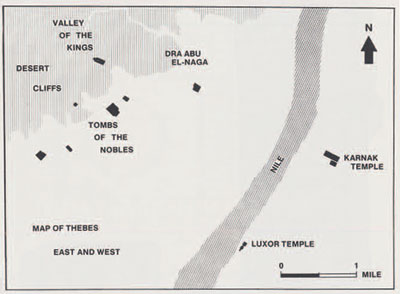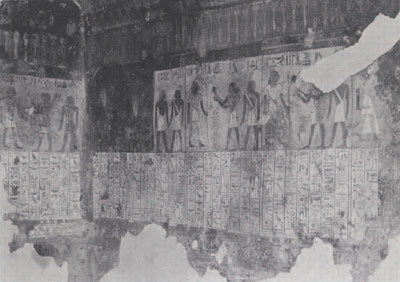
Dra abu el Naga is the Arabic name for a site in Thebes, north of Deir el Bahri, not too far from the Valley of the Kings. This part of the Theban necropolis is of especial interest to the University Museum today just as it was several decades ago. Through monies from the Coxe Fund, Clarence Fisher directed two seasons of work from 1921 to 1923 for the Museum. He concentrated mainly on the decorated tombs of Ramesside officials, but he worked as well in the Eighteenth Dynasty mortuary temple of Amenhotep I and his wife Ahmose-. Nefertari. Published in a preliminary report (see The Museum Journal, XV, 2, 28-49), the results of Fisher’s work still await full publication, although research on the excavation and the finds has continued over the years.
Early in 1967 the University Museum reaffirmed its commitment to the work already begun there, and Lanny Bell went to Dra abu el Naga as Assistant Investigator to examine the site. He hoped to be able to extricate the complicated genealogical, historical, and religious information hidden in the archaeological material. Professor Cerny, who was Visiting Curator at the Museum and Visiting Professor for the University, was an exceptional mentor, for his reputation as an epigrapher, philologist, and historian was rarely equalled. He acted as the Adviser for the survey, and Dr. David O’Connor, who had originated the movement toward publishing the past excavations, was the Principal Investigator. In this first season (see Expedition, 10, #2, Winter 1968, pp. 38-47), Bell examined the site in detail, and he, Cerny, and O’Connor selected three tombs: 35 (Bekenkhons), 157 (Nebwenenef), and 283 (Setau). To this first group was added a second: 156, 289, and 300 with others following at a later date. Having submitted an application to the authorities, work on tomb 35 was begun, the first stage of which was to collate the 1921-23 copies of the inscriptions against the original version.

In the second season (winter 1968; see the reports in Expedition 11, #3, Spring 1969, 28-43), Field Director Bell was assisted by Ray Slater of the Egyptian Section and Geoffrey Pearce, a British conservator. As was the case with the first season, the financing was by the Coxe Fund and the Smithsonian administered counterpart funds (PL 83-480). Bell and Slater continued collating the texts in tomb #35, correcting earlier misreadings and the resulting conclusions and discovering new texts. Pearce directed the cleaning and repair. The goals of the expedition were not only to extract as much information as possible from the pharaonic remains but also to conserve and reconstruct these monuments for many more generations.
The staff also began the laborious task of clearing tomb 157, the interior of which had much debris from the successive years of occupation, including evidence to indicate that it had at one time been used as a Coptic sanctuary. On the walls, they found extremely fine raised relief from the Ramesside period, but most of the painted plaster decoration had decomposed. The pillars in Nebwenenef’s broad hall were reconstructed and a ceiling shored up.
They brought electricity into tomb 35 which would be accessible to other locations, and they began the exterior stonework for tombs 289 and 300 in which the protective iron doors would be placed. Tomb 289 was opened, but because of evident extensive damage caused by bats, it was resealed until a later time, The University Museum site now comprising 14 tombs was fully inspected and carefully looked after.

Successive seasons saw the further clearing of the Nebwenenef tomb and the completion of the collation of texts in tomb 35. Archaeological work was directed by Martha Bell and her assistants, and the staff in general was enlarged to accommodate the increasing range of the projects. No part of the concession at Dra abu el Naga was left uncared for and with each survey, cleaning, and collation, exciting discoveries were made. In the winter of 1973, Bell stated, “We have now to revise the biographies of Nebwenenef, Bekenkhons I and II, and Roma-Roy, to evaluate their places within the succession of High Priests of Amun during Dynasties XIX and XX (1320-1085 B.C.).” As Dra abu el Naga continues to be sifted through, it is clear that more such enlightening information will be forthcoming.
